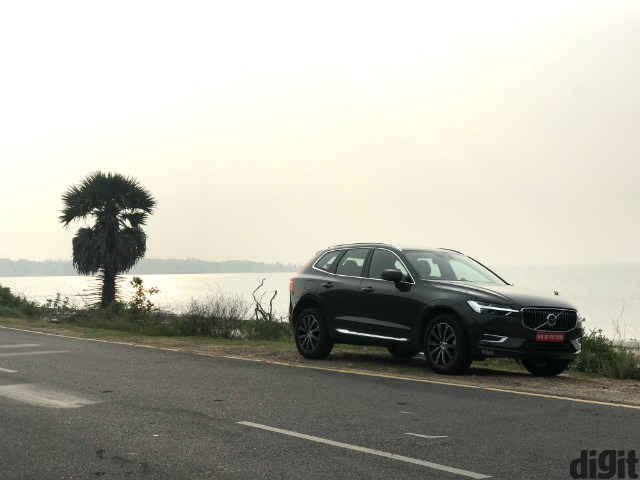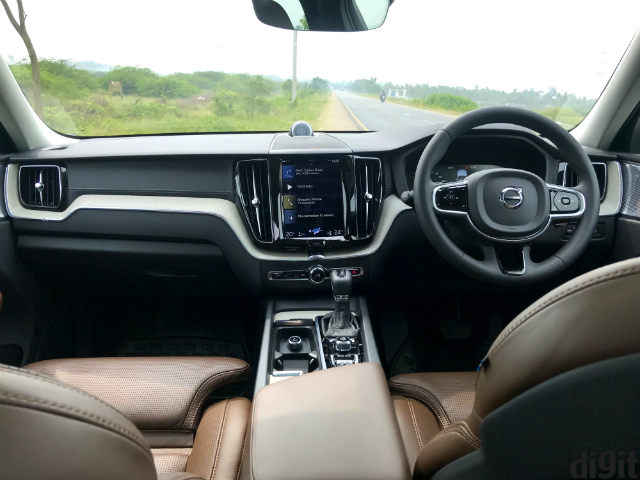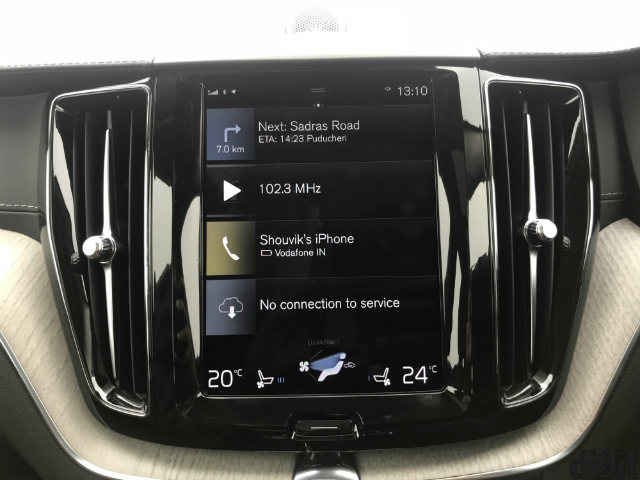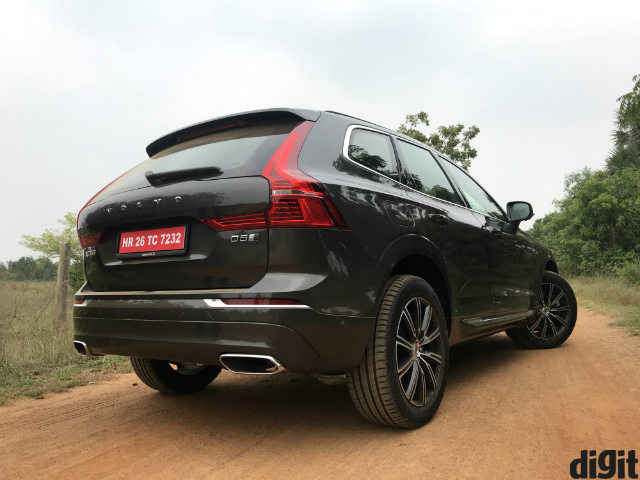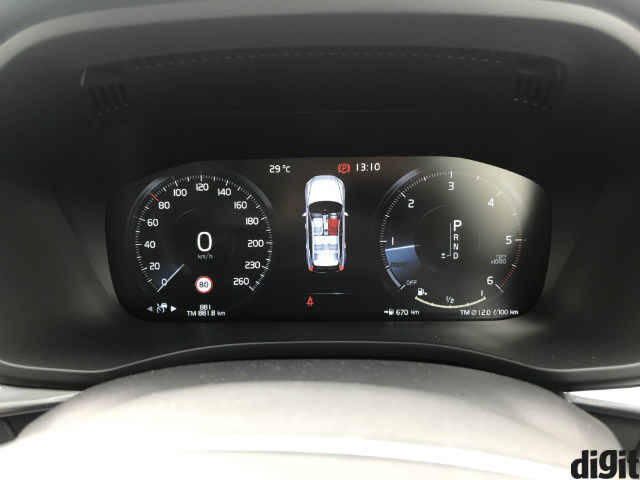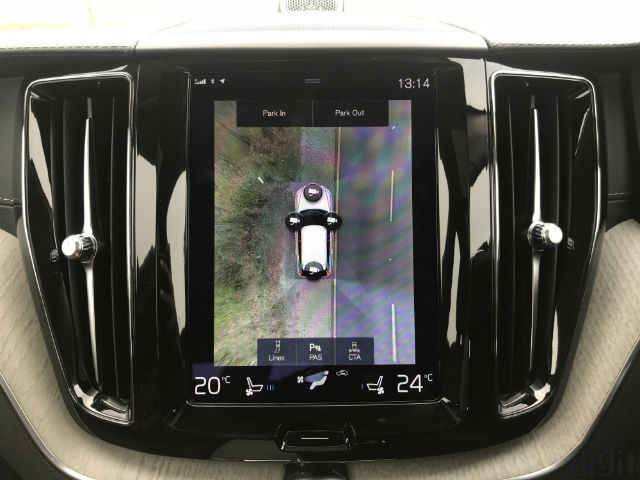2017 Volvo XC60 technology, drive review: A notable inscription
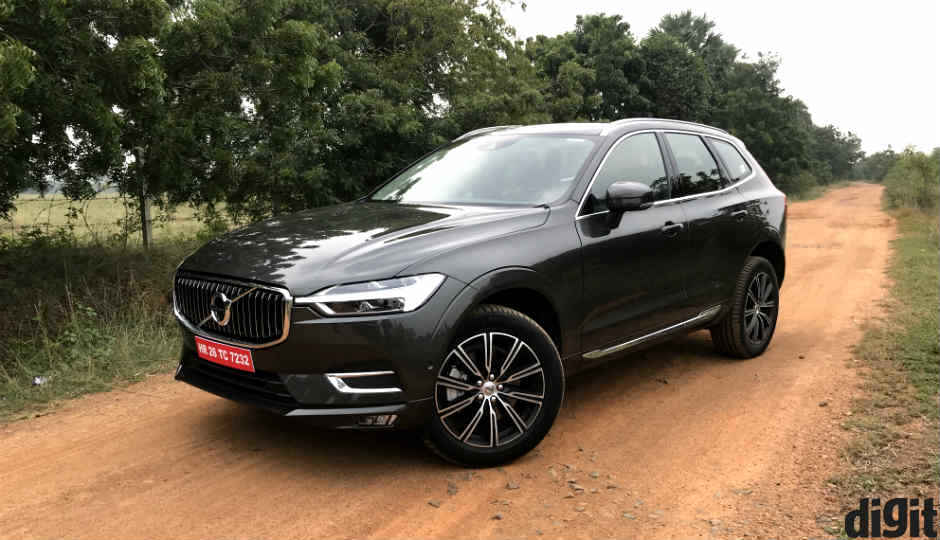
The 2017 Volvo XC60 is deeply impressive, and comes with technologies that are well beyond what any other car maker provides in India right now.
SUVs are pretty much the only type of cars that sell in India these days, and the luxury segment is no different. At this point, the 2017 Volvo XC60 arrives in India with everything that you would expect from luxury SUVs – classy interiors, fancy LEDs, a fairly powerful engine and a lot of leather and wood. While all that sounds perfectly suited for the luxury SUV customer in India, what the XC60 really stands out for is the level of technology that it brings to the mid-sized luxury SUV segment.
Volvo Auto India prides that it is the only car maker to provide radar-equipped cars in India presently, and rightfully so. The 2017 XC60 is the fifth car built on Volvo’s modular Scalable Product Architecture platform, which Volvo has invested $1.5 billion in. The result of this quite massive investment is a new platform that can accommodate batteries on the floor for Volvo’s plug-in hybrid models without compromising on boot or cabin space, and be modular to fit in different wheelbases. Alongside, the new car comes with radar, five cameras, proximity sensors, algorithms that recognise road signs, automatically read GPS data, measure trajectories of approaching obstacles, maintain distance and speed according to surroundings, and keeps the car within its lane. This makes it the fifth car in the country to be equipped with all the paraphernalia essential to enable Level Two of autonomy in cars. The other four cars that have similar abilities are Volvo XC90, Volvo S90 Polestar, Volvo V90 and Volvo V90 Cross Country, all part of Volvo’s latest generation of cars that use the SPA platform.
Interface ergonomics
The list of assistive features in the Volvo XC60 including lane keeping aid, parallel and perpendicular handsfree parking, cross traffic alert, car distance and speed alert, multi-view cameras, blind spot identification, collision avoidance system, road sign identification, speed limit alert and more. Each of these, on an individual or collaborative level, take over the steering wheel, acceleration and braking in limited levels. All prompts, actions, symbols and notifications are relayed via the digital instrument cluster and the high resolution augmented Head-Up Display, and can be operated via the 9-inch portrait display taking up much of the dashboard’s central column.
Volvo’s Sensus interface is seamless and easy to operate, and the simplicity of the HMI design means you can activate or deactivate any of the assistive features with one tap on the central infotainment display. You get an infotainment system that closely resembles an iPad, which brings familiarity, and the clearly defined interface means the learning curve is quite gentle. There are three main screens, along with a drop-down notifications panel that serves alerts on driving dynamics and other prompts. The first screen is a shortcut hub of sorts, which show primary infotainment and driving assist icons — FM/AM/Radio favourites, CD, Bluetooth, USB and iPod for audio sources, Sound Experience, Message prompts, car status, driving performance, a download centre, and Apple CarPlay and Android Auto.
The second screen serves as the primary home screens, with four horizontal rows denoting the integrated sat-nav, the audio source, phone controls and the in-car internet connectivity status. This second screen is the one that you’ll mostly be accessing, to input destinations or access the map for looking up points of interest or other nearby landmarks, switch between multiple audio sources, make calls or access the quick dial lists, and also access the internet when the car is standing. The third screen is the hub for all car functions, which you’ll presumably adjust less frequently. These include switches for all the advanced car functions, parking assist, the 360-degree camera, HUD, seat and headrest adjustments, and more. It is the features provided here that we’ll focus on primarily.
All of this makes for a very ergonomic infotainment interface, one where all the features available in the 2017 Volvo XC60 are mentioned clearly and easily. Each tab is further denoted by a green label when the feature is switched on, and the touchscreen itself is incredibly smooth, to a point where we could not spot a single stutter in over four hours of fidgeting around with it. The large size of the display also means that all the texts are very clearly visible, and the muted colour theme ensures that you do not get distracted while driving. There is a very appreciable sense of neatness to the entire system, which not only makes this one of the most ergonomic infotainment displays around, but also one of the best designed in terms of looks, ease of usage, and the premium feel. Everything here simply exudes a sense of confidence, which is admirable.
The assisted drive
We have previously driven a prototype advanced vehicle at ZF’s global summit, which came with more advanced controls for a higher level of autonomy in the car. The production-form Volvo XC60 is not as unnerving, but that is also primarily because it does not even look like any of the concept autonomous cars that you’d spot across the internet.
As a result, when you enter the driver’s seat and take the steering wheel, you may initially wonder why the steering wheel feels restrained and does not let you simply swerve from one lane to the other. Drive down the wonderful East Coast Road, the Volvo XC60’s radar, sensors and cameras easily recognised the lane markings, and the steering makes micro adjustments by itself to keep you within a particular lane as you speed through. It is not a visibly apparent process, but is one that you spot when you take your hands off the wheel as you approach gentle curves. This is, of course, not suggested, even though the system is more than proficient to handle highways by itself. Alongside, you get blind spot alerts on both the side view mirrors, which beep and blink red simultaneously to alert you if a vehicle is approaching you at a higher speed than what you are at.
Furthermore, you get distance and speed maintenance, where the car’s sensors automatically gauge the speed of the car in front of you and its trajectory, tallies with itself, and maintains the speed and distance from the car right in front of it. This can be enabled when you switched on the assisted cruise control, and is probably what makes a whole world of difference in long highway cruises. Alongside maintaining the speed, the 2017 Volvo XC60 can also slow down, recognise approaching cars on other lanes, and maintain its own lane at a safe distance from all other cars around, which not only makes it supremely intelligent, but also a very assured car to drive in.
Another intuitive feature about the 2017 Volvo XC60 is the road sign recognition, where the car’s satellite-based navigation recognises speed limits and road sign alerts, and relays the same to the digital instrument cluster and the HUD. This still helps you in keeping your focus on the road, while bringing your attention to the persisting speed limit sign on the stretch of road you’re on, which you may have missed. It also relays signs such as ‘School ahead’ and turns, making it a very complete navigation assistance setup. This is further paired with five cameras spread across the car, which helps you to see tight corners on narrow alleyways on the central display, and autonomously alerts you of approaching cars from acute angles that are out of your line of sight.
The assisted drive features of the 2017 Volvo XC60 also include handsfree parking, capable of recognising parallel and perpendicular parking spots, along with park-out. These assisted parking features work similar to how they function in Volkswagen Group’s cars, which have so far been the most consistent among what’s on offer in India. The interface is actually more intuitive than what you see in VWs, which in turn makes it easier to operate. The suspension height can also be adjusted as per terrain, and stiffen/soften up according to it. Alongside, you can also lower the suspension to load luggage on to the pretty spacious boot, via a switch on the inner right side of the boot space.
The assistive technology package also continues with the front seats, both of which get electronic adjustments for pitch, recline, side bolstering, thigh support, lumbar support, and four different massage patterns that can be adjusted in terms of speed and intensity, thereby matching the comfort of a BMW 7’s seat in terms of support and comfort. Even the headrests can be electronically adjusted to find the perfect support of seating. The front lights can also be put on active bending mode, which turn according to the trajectory of the car. This is further highlighted with cornering lights, which in combination with the front cameras, make for supreme visibility in tight roads.
Infotainment and Audio
The 2017 Volvo XC60’s infotainment system offers a very easy-to-use interface, which we have already discussed before. Making calls on the move is seamless, both via the touch interface or the voice assistant. All the tabs are very well organised, and has an iOS-like flow about it. The highlight of the XC60’s in-cabin technology, however, is the audio setup.
The Volvo XC60 includes a 15-speaker Bowers & Wilkins audio setup, along with a subwoofer that is concealed very well within the cab so as to avoid any discontinuity in design. It is also placed quite well in terms of the audio performance, which is, for its segment, quite impressive. The setup is comparable to the bright, true-to-source sound signature that Bentley’s Naim audio system produces, and while it is certainly not similar, this enough is high praise. The highs are prominent, bass delivery is solid, and mid frequencies are not compromised in any way. It certainly outperforms the Harman/Kardon audio systems of BMW, and the Canton setup used by Skoda – which happen to be among the best in their respective classes. Couple that with great surround audio performance, and what you get is one of the best in-car audio setups that you can get at around this price. Only Mercedes-Benz’s Burmester-powered audio systems sound as splendid and rich as the Bowers & Wilkins speakers do in the Volvo XC60.
Drive
The 2017 Volvo XC60 comes to India only in its top-trim Inscription variant, powered by a 2-litre, 4-cylinder turbocharged diesel engine that produces 234bhp and a staggering 480Nm of torque. The AWD SUV is further paired with an 8-speed automatic gearbox, which changes the gear ratios depending on the mode that you’re driving in.
In effect, what you get is an engine that is more than adequately powerful, and despite being a turbocharged diesel engine, it comes with a proprietary Volvo technology called ‘PowerPulse’. What this does is include a small tank of compressed air within the comparatively tiny diesel engine (for such a large SUV). When the car starts and before the turbocharger kicks in, the PowerPulse tank pulses in short bits of pressurised air into the engine’s pistons, which makes up for the lack in turbo power at the initiation, and also maintains the overall efficiency of the engine’s combustion.
While this sounds quite commendable on paper, the 2017 Volvo XC60 comes with literally no turbo lag, uncharacteristic of most diesel engines. What you get is a smooth, upward surge of power, which allows you to push the SUV hard right from the onset. The suspension is strung on the softer side to aid comfort, but you can set it to be stiffer by selecting Dynamic or Off-Road modes. The intelligent suspension height adjustment also helps the new XC60 maintain its composure, and this makes the 2017 Volvo XC60 an incredible car to ride in.
The only wee bit of disappointment is in the rather light steering wheel. While everything about this SUV feels impeccably balanced, the steering wheel is a tad too light for a car of its dimensions. Even when it weighs up as you hit the highway, you feel a slight sense of disconnect, a slight something that is missing from the rest of the car’s characteristics – the incredible range of technology inside, the supreme audio system, the very able engine, oodles of torque, a pliant and stable ride. The light steering wheel comes in handy in city driving, which makes the SUV a bit more effortless than what you’d expect. However, the slight disconnect remains at the back of your mind, and is something that could have been improved.
Design
Volvo’s $1.5bn investment in its SPA platform means that it now has a common chassis that can be used for different body forms. The 2017 Volvo XC60, as a result, borrows a lot from the much larger Volvo XC90. The distance between the characteristic front grille and the driver’s seat is maintained from the larger XC90, while the overall dimensions are trimmed.
This, however, makes the car look much better than the XC90, at least in our books. It looks more proportionate, the design language – from the Thor’s Hammer headlamps to the slightly bulging body, the swept-out back and the side-hugging tail LEDs all flow seamlessly into a body that looks like it has been built from scratch, and is not shared with its brethren. In effect, it also makes the SUV look less unwieldy and much more tidy, and even sleeker than competitors like the Mercedes-Benz GLE and the BMW X5.
The only qualm may be that while it does look smarter than before, the 2017 Volvo XC60 still looks rather identical to the outgoing generation XC60. However, if you are buying a luxury SUV for the first time, this factor will certainly not deter you from considering the new XC60 to be quite soothing to the eyes. On the inside, the new XC60 includes a new open pore veneer trim on the dash that is finished very smoothly, and comes with three leather trims – amber, beige and dark tan. The dark tan, in particular, makes the contrasting shades come out really nicely, and befit the premium tag of the vehicle. You get plenty of lighting inside, a three-zone automatic climate control system, a panoramic sunroof and ample legroom for every passenger of the five-seater SUV.
Verdict
The 2017 Volvo XC60 had us discussing its technology arsenal for almost 30 minutes on our Facebook Live discussion about it, and even write a near novel on it. The thing is, it is one of those cars that have a host of intricate and advanced technologies, and is one of the very few of its kind that provide a near overload of features. That said, it still does not pose an overwhelming sense of distraction to the driver, and packs all the technology into a neat, user friendly interface.
The new Volvo XC60 has a lot of tempting elements on offer for luxury SUV buyers, and can provoke a serious thought to divert away from the usual preferences. Volvo states that the XC60 is its bestselling car across the world, and we expect the 2017 Volvo XC60 to be the same in India, as well. Launched today, and priced very competitively at Rs. 55.9 lac (ex-showroom, pan-India), the 2017 Volvo XC60 has everything that it should take to finally make Volvo gain a larger share of the Indian luxury car market.
More photos

